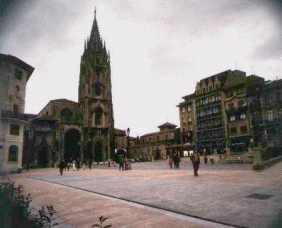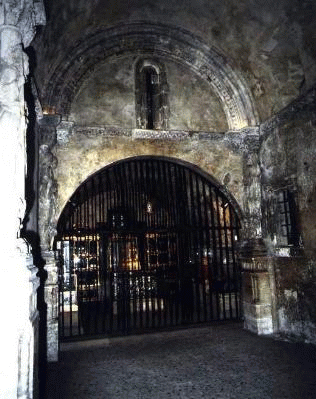|
Treasures of the Church-
Miraculous Images of Jesus |
The Shroud of Oviedo
A cloth that covered the face of Christ
written by SCTJM

Physical and Historical descriptions
Northern Spain in the Cathedral of Oviedo, we find a special relic:
a piece of cloth about 84 x 53 cm. The cloth doesn’t have an image.
The only thing that is seen is spots of blood, seen better through a
microscope. What is so magnificent is that tradition as well has
science maintain that this cloth was the one utilized to cover and
clean the face of Jesus after the crucifixion.
Saint John’s gospel, chapter 20, verse 6 & 7, mentions the cloth;
“Then Simon Peter came following him and entered the tomb; he, too,
saw the linen cloths lying flat. The napkin, with had been around
his head was not lying flat like the other linen cloths but lay
rolled up in its place”. John makes a clear distinction between the
cloth that is smaller, the shroud and the linen cloths that covered
Jesus’ entire body.
The difference between the Shroud of Turn, the historical Shroud
well documented is very clear.
Most of the information comes from the XII century, bishop Pelayo of
Oviedo.
The Shroud entered through Cartagena, Spain, in 616, taken by
fleeing Persia. Bishop Fulgencio of Ecija, welcomed the refugees
with their relics in the “Holy Arc”, a chest made of cedar wood
covered with silver and decorated with pictures of the gospels.
Because of the revolution of the year 34, many of the relics in the
chest disappeared, reduced to the one of St. Peters sandals, St.
Andrews purse, five thorns from the crown of thorns and a piece of
the Holy Shroud.
Later on St. Isidore was named bishop of Sevilla and teacher of St.
Ildelfonso, assigned bishop of Toledo. After leaving Sevilla, for
his new mission St. Ildelfonso took the holy chest with him. The
chest stayed in Toledo till the year 718. To protect the chest from
falling into the hands of the Muslims, it taken to the north of the
country. In the beginning it was safeguarded in a cave, called
Monsacro, ten kilometers from Oviedo. King Alfonso II ordered a
special chapel to be constructed for the holy chest: they named it “
Holy Chamber “ or “ Holy House “, to made a cathedral later on were
the holy chest still remains.
Analysis of the Shroud
 The
spots on the Shroud reveal that the cloth was put over Jesus’ face
after his death. It was folded twice, not in the middle. If both
sides of the cloth are counted, a quadruple spot can be found,
logically diminishing in intensity.
The
spots on the Shroud reveal that the cloth was put over Jesus’ face
after his death. It was folded twice, not in the middle. If both
sides of the cloth are counted, a quadruple spot can be found,
logically diminishing in intensity.
According to the composition of the multiple main spots, it can be
distinguished in an evident way that the Shroud which covered the
man (Jesus) face died in a vertical position. Parts of the spots is
blood and six parts is liquid from pleural enema. This liquid is
concentrated in the lungs when the crucified person dies
asphyxiated, causing the liquid flows from the nasal passages.
These spots from the nasal area are found over each other, with
different prominence, seen with clarity. This means that the first
blood spot dried up when the second was formed, and successively.
The cloth did not cover Jesus face completely because his left cheek
was almost touching his right arm.
This indicates that the Shroud was placed on Jesus’s face while
still on the Cross. When the body was taken down from the Cross,
approximately one hour later, the second spot of blood was formed.
The third blood spot was formed about forty five minutes later,
after the body of our Lord was raised from the ground. The body of
Jesus remained at the foot of the Cross about fifty five minutes
before its burial. The marks of the fingers that sustained the cloth
can also be seen, in the nasal area.
Various experiments and studies confirm that the blood spots, at the
moment of Jesus’s death, reveals his head to be inclined seventy
degrees towards the front and twenty towards the right. The position
clearly indicates that the man whose face covered the cloth died
crucified.
Next to the main blood spots, appears other small ones. All
indicates that the shroud was hooked to the back of Our Lord’s head
when he died, and these spots where caused by sharp objects,
obviously they were the thorns form the crown of thorns.
Among the medical studies done, Doctor Max Frei made an analysis
with samples of pollen taken from the Shroud and found species from
de Oviedo, from Toledo, North Africa and Jerusalem. This test
confirms the historical route of the shroud previously described.
Nothing was found related to Constantinople or any other country in
Europe. Doctor Frei demonstrated that the species of pollen found on
the cloth are called
“quercus caliprimus“ only found in the Palestine area.
We read in the gospel of St. John (19:39-40): “Nicodemus, the man
who earlier had come to Jesus by night, also came and brought a jar
of myrrh mixed with aloes, about a hundred pounds. They took the
body of Jesus and wrapped it in linen cloths with the spices,
following the burial custom of the jews”.
Also anthropological studies of the blood spots were taken. As a
result, it has been confirmed that the face in contact with the
shroud was of a person with prominent cheekbones and prominent nose,
typical characteristics of a Jewish person.
To conclude, just to know that this cloth has been preserved for so
long is a sign of authenticity. All the studies done indicate,
without contradiction one from the other, that the Shroud covered
the Head of Jesus of Nazareth from the moment he was taken down from
the Cross till his burial.
Similarities or coincidences with the Shroud of Turin
 Sufficient
information has revealed to confirm that the Shroud has been in
contact with the Face of Jesus
Sufficient
information has revealed to confirm that the Shroud has been in
contact with the Face of Jesus
after crucifixion. However, these tests are more fascinating when we
compare them with the Shroud of Turin.
The most convincing coincidence is that the blood that appears on
both cloths are AB type. The nose measurement are exactly the same
in both, eight centimeters, a little more then three inches.
Another interesting fact is that if the image of the Shroud of
Oviedo is placed over the Shroud of Turin , perhaps the most obvious
coincidence is that the spots match perfectly with the beard and the
face. It seems a custom of the time that the shroud was used to
clean the face, with out any movement of cleaning, only placed to
absorb the blood.
On the right side of the mouth, a spot appears. In the back of the
neck, the wounds from the thorns also coincide perfectly with the
blood spots from the Shroud of Turin.
Doctor Alan Whanger applied a special technique to the Shroud,
called ‘Polarized Covering of the Image’ comparing it to the image
and the spots from the Shroud of Turin.
The spots in the front of the Shroud revealed seventy spots that
coincided with other Shroud, and the back side had fifty. The only
conclusion possible is that the Shroud of Oviedo covered the same
face has the Shroud of Turin.
Apparent aspects of the Shroud compared with the Shroud of Turin
No image is found in the Shroud of Oviedo, neither the dry spots of
blood that are seen in the Shroud of Turin, particularly the spot in
front, in three dimension form.
Jewish tradition require that the face of the dead be covered with
cloth if it is disfigured, to avoid others from seeing the
unpleasant sight. This was the case of Our Lord Jesus, his face full
of blood because of his wounds caused by the crown of thorns,
swelled by falls and blows.
All seems to indicate, that from the beginning the Shroud was used
before the body was taken down from the
Cross the dead body of Jesus and it was discarded after the burial.
This fits perfectly to what the gospel of Saint John narrates, the
linen cloth lay rolled up in its place.
This page is the work of the Servants of the Pierced Hearts of Jesus and
Mary